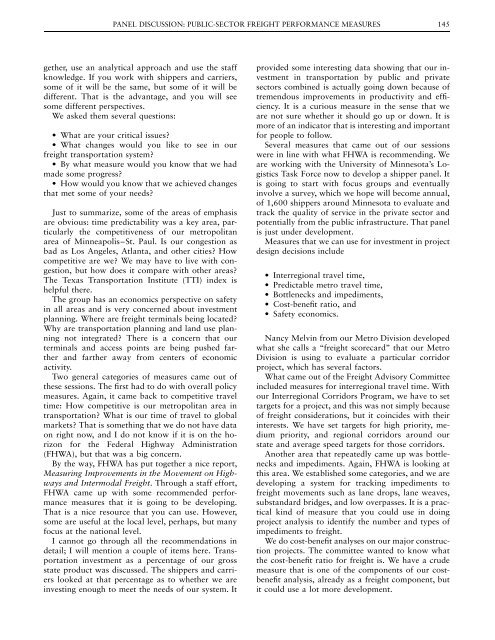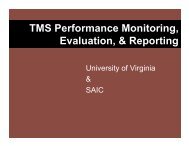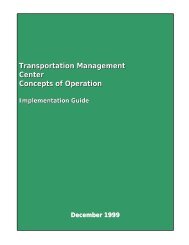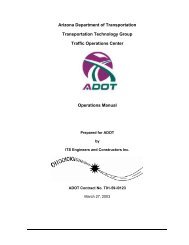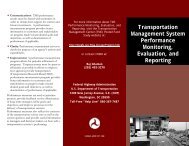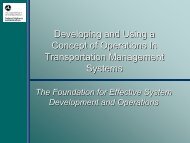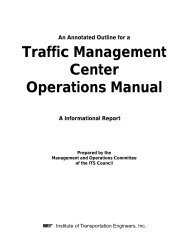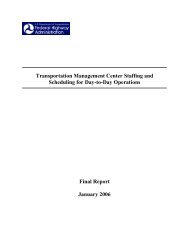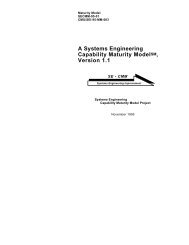144 PERFORMANCE MEASURES TO IMPROVE TRANSPORTATION SYSTEMS AND AGENCY OPERATIONSTABLE 1 Proposed Performance Measures with Available Data forMinnesota’s Freight <strong>Transportation</strong> SystemProposed MeasurePredictable, CompetitiveMetro-Area Travel TimeEconomic Cost-Benefit Ratio<strong>Transportation</strong> InvestmentData AvailableMetro freeway travel time by route and time of dayAverage speed on metro freeways by route and time of dayCongestion ranking of metro freeways by routeCongestion level compared with other major metropolitan areasCost-benefit ratio of major state transportation projects aMinnesota’s transportation investment and spending as percentageof gross state product baData are available for most projects showing a benefit for heavy trucks. A project financial analysis modelhas been created by MnDOT Metro.bPublic-sector data are available.devised the concepts, not specific measures. TheFreight Advisory Committee emphasized• Time—predictable and competitive;• Economic impact—across all areas (time, safety,access, and infrastructure);• Economic competitiveness—in time and cost ofshipping; and• Investment planning—cost-benefit ratio and locationof facilities.After that session, we brought people in from differentparts of the department and analyzed andtranslated the concepts into potential measures.Then, we looked at whether the data were reallyavailable. (Tables 1 and 2 summarize the currentstatus of these measures.) After the staff work wasdone, we brought it back to the group; membersmade a few modifications and gave it their blessing.A few of the measures have been implemented, butwe have a long way to go to bring it all into ourprogram.I should step back and say, How do you developfreight measures? Well, you could get your staff to-TABLE 2 Proposed Performance Measures Requiring Development forMinnesota’s Freight <strong>Transportation</strong> SystemProposed MeasureIntercity Travel TimeFreight Travel Time to Global MarketsCompetitiveness of Shipping RatesCrash Rate and Cost ComparisonBottlenecks and ImpedimentsTimely Access to Intermodal TerminalsData neededPeak-hour average travel speeds on major highway routes between27 regional centers aShipper point-to-point travel time bTravel time to major regional, national, and global markets by rail,air, water, and truck cShipment cost per mile by ton or value by mode for major commoditiesdDollar value of crashes and crash cost comparison by mode eCrash rate per mile traveled (or other basis) by freight mode cNumber of design impediments to freight traffic by mode and type(at-grade rail crossings, restricted roads, deficient bridges, etc.) fNumber of design impediments slowing access to truck, rail, air, andwaterways terminals gaCalculated speeds; preliminary development has been done for the MnDOT Interregional Corridors Study.bDeveloped from private data.cRequires development.dRequires research and development.eSome data are available; requires development.fData for some types are available; others need development.gSome data are under development.
PANEL DISCUSSION: PUBLIC-SECTOR FREIGHT PERFORMANCE MEASURES 145gether, use an analytical approach and use the staffknowledge. If you work with shippers and carriers,some of it will be the same, but some of it will bedifferent. That is the advantage, and you will seesome different perspectives.We asked them several questions:• What are your critical issues?• What changes would you like to see in ourfreight transportation system?• By what measure would you know that we hadmade some progress?• How would you know that we achieved changesthat met some of your needs?Just to summarize, some of the areas of emphasisare obvious: time predictability was a key area, particularlythe competitiveness of our metropolitanarea of Minneapolis–St. Paul. Is our congestion asbad as Los Angeles, Atlanta, and other cities? Howcompetitive are we? We may have to live with congestion,but how does it compare with other areas?The Texas <strong>Transportation</strong> Institute (TTI) index ishelpful there.The group has an economics perspective on safetyin all areas and is very concerned about investmentplanning. Where are freight terminals being located?Why are transportation planning and land use planningnot integrated? There is a concern that ourterminals and access points are being pushed fartherand farther away from centers of economicactivity.Two general categories of measures came out ofthese sessions. The first had to do with overall policymeasures. Again, it came back to competitive traveltime: How competitive is our metropolitan area intransportation? What is our time of travel to globalmarkets? That is something that we do not have dataon right now, and I do not know if it is on the horizonfor the Federal Highway Administration(FHWA), but that was a big concern.By the way, FHWA has put together a nice report,Measuring Improvements in the Movement on Highwaysand Intermodal Freight. Through a staff effort,FHWA came up with some recommended performancemeasures that it is going to be developing.That is a nice resource that you can use. However,some are useful at the local level, perhaps, but manyfocus at the national level.I cannot go through all the recommendations indetail; I will mention a couple of items here. <strong>Transportation</strong>investment as a percentage of our grossstate product was discussed. The shippers and carrierslooked at that percentage as to whether we areinvesting enough to meet the needs of our system. Itprovided some interesting data showing that our investmentin transportation by public and privatesectors combined is actually going down because oftremendous improvements in productivity and efficiency.It is a curious measure in the sense that weare not sure whether it should go up or down. It ismore of an indicator that is interesting and importantfor people to follow.Several measures that came out of our sessionswere in line with what FHWA is recommending. Weare working with the University of Minnesota’s LogisticsTask Force now to develop a shipper panel. Itis going to start with focus groups and eventuallyinvolve a survey, which we hope will become annual,of 1,600 shippers around Minnesota to evaluate andtrack the quality of service in the private sector andpotentially from the public infrastructure. That panelis just under development.Measures that we can use for investment in projectdesign decisions include• Interregional travel time,• Predictable metro travel time,• Bottlenecks and impediments,• Cost-benefit ratio, and• Safety economics.Nancy Melvin from our Metro Division developedwhat she calls a ‘‘freight scorecard’’ that our MetroDivision is using to evaluate a particular corridorproject, which has several factors.What came out of the Freight Advisory Committeeincluded measures for interregional travel time. Withour Interregional Corridors Program, we have to settargets for a project, and this was not simply becauseof freight considerations, but it coincides with theirinterests. We have set targets for high priority, mediumpriority, and regional corridors around ourstate and average speed targets for those corridors.Another area that repeatedly came up was bottlenecksand impediments. Again, FHWA is looking atthis area. We established some categories, and we aredeveloping a system for tracking impediments tofreight movements such as lane drops, lane weaves,substandard bridges, and low overpasses. It is a practicalkind of measure that you could use in doingproject analysis to identify the number and types ofimpediments to freight.We do cost-benefit analyses on our major constructionprojects. The committee wanted to know whatthe cost-benefit ratio for freight is. We have a crudemeasure that is one of the components of our costbenefitanalysis, already as a freight component, butit could use a lot more development.
- Page 5 and 6:
National Academy of SciencesNationa
- Page 7 and 8:
Workshop Summary ..................
- Page 9:
General OverviewIntroductionExecuti
- Page 12 and 13:
4 PERFORMANCE MEASURES TO IMPROVE T
- Page 14 and 15:
6 PERFORMANCE MEASURES TO IMPROVE T
- Page 18 and 19:
10 PERFORMANCE MEASURES TO IMPROVE
- Page 20 and 21:
12 PERFORMANCE MEASURES TO IMPROVE
- Page 23:
Linking Performance Measures withDe
- Page 26 and 27:
18 PERFORMANCE MEASURES TO IMPROVE
- Page 28 and 29:
20 PERFORMANCE MEASURES TO IMPROVE
- Page 30 and 31:
22 PERFORMANCE MEASURES TO IMPROVE
- Page 32 and 33:
24 PERFORMANCE MEASURES TO IMPROVE
- Page 34 and 35:
26 PERFORMANCE MEASURES TO IMPROVE
- Page 36 and 37:
28 PERFORMANCE MEASURES TO IMPROVE
- Page 38 and 39:
30 PERFORMANCE MEASURES TO IMPROVE
- Page 40 and 41:
32 PERFORMANCE MEASURES TO IMPROVE
- Page 42 and 43:
Panel DiscussionJohn Poorman, Capit
- Page 44 and 45:
36 PERFORMANCE MEASURES TO IMPROVE
- Page 46 and 47:
38 PERFORMANCE MEASURES TO IMPROVE
- Page 48 and 49:
Workshop SummaryJohn Basilica, Loui
- Page 50 and 51:
42 PERFORMANCE MEASURES TO IMPROVE
- Page 52 and 53:
44 PERFORMANCE MEASURES TO IMPROVE
- Page 55 and 56:
RESOURCE PAPERImplementing Performa
- Page 57 and 58:
IMPLEMENTING PERFORMANCE MEASUREMEN
- Page 59 and 60:
IMPLEMENTING PERFORMANCE MEASUREMEN
- Page 61 and 62:
IMPLEMENTING PERFORMANCE MEASUREMEN
- Page 63 and 64:
IMPLEMENTING PERFORMANCE MEASUREMEN
- Page 65 and 66:
IMPLEMENTING PERFORMANCE MEASUREMEN
- Page 67 and 68:
Panel DiscussionJennifer Finch, Col
- Page 69 and 70:
FIGURE 2Level of measures and align
- Page 71 and 72:
PANEL DISCUSSION: AGENCY IMPLEMENTA
- Page 73 and 74:
PANEL DISCUSSION: AGENCY IMPLEMENTA
- Page 75 and 76:
PANEL DISCUSSION: AGENCY IMPLEMENTA
- Page 77 and 78:
PANEL DISCUSSION: AGENCY IMPLEMENTA
- Page 79 and 80:
WORKSHOP SUMMARY: AGENCY IMPLEMENTA
- Page 81:
Selecting Measures, Data Needs, and
- Page 84 and 85:
76 PERFORMANCE MEASURES TO IMPROVE
- Page 86 and 87:
78 PERFORMANCE MEASURES TO IMPROVE
- Page 88 and 89:
80 PERFORMANCE MEASURES TO IMPROVE
- Page 90 and 91:
82 PERFORMANCE MEASURES TO IMPROVE
- Page 92 and 93:
84 PERFORMANCE MEASURES TO IMPROVE
- Page 94 and 95:
86 PERFORMANCE MEASURES TO IMPROVE
- Page 96 and 97:
Panel Discussion, Part 1Anita Vande
- Page 98 and 99:
90 PERFORMANCE MEASURES TO IMPROVE
- Page 100 and 101:
92 PERFORMANCE MEASURES TO IMPROVE
- Page 102 and 103: Panel Discussion, Part 2Douglas Zim
- Page 104 and 105: FIGURE 11 Example data
- Page 106 and 107: 98 PERFORMANCE MEASURES TO IMPROVE
- Page 108 and 109: Workshop SummaryBrenda Berg, Trans
- Page 110 and 111: 102 PERFORMANCE MEASURES TO IMPROVE
- Page 113 and 114: RESOURCE PAPERMeasuring That Which
- Page 115 and 116: MEASURING THAT WHICH CANNOT BE MEAS
- Page 117 and 118: TABLE 1Sustainability MeasuresNewma
- Page 119 and 120: MEASURING THAT WHICH CANNOT BE MEAS
- Page 121 and 122: MEASURING THAT WHICH CANNOT BE MEAS
- Page 123 and 124: MEASURING THAT WHICH CANNOT BE MEAS
- Page 125 and 126: MEASURING THAT WHICH CANNOT BE MEAS
- Page 127 and 128: MEASURING THAT WHICH CANNOT BE MEAS
- Page 129 and 130: MEASURING THAT WHICH CANNOT BE MEAS
- Page 131 and 132: MEASURING THAT WHICH CANNOT BE MEAS
- Page 133 and 134: MEASURING THAT WHICH CANNOT BE MEAS
- Page 135 and 136: PANEL DISCUSSION: CONNECTING SYSTEM
- Page 137 and 138: PANEL DISCUSSION: CONNECTING SYSTEM
- Page 139 and 140: PANEL DISCUSSION: CONNECTING SYSTEM
- Page 141 and 142: PANEL DISCUSSION: CONNECTING SYSTEM
- Page 143 and 144: Workshop SummaryScott Bassett, Oreg
- Page 145: Freight Performance MeasuresCurrent
- Page 148 and 149: 140 PERFORMANCE MEASURES TO IMPROVE
- Page 150 and 151: 142 PERFORMANCE MEASURES TO IMPROVE
- Page 154 and 155: 146 PERFORMANCE MEASURES TO IMPROVE
- Page 156 and 157: 148 PERFORMANCE MEASURES TO IMPROVE
- Page 158 and 159: 150 PERFORMANCE MEASURES TO IMPROVE
- Page 160 and 161: 152 PERFORMANCE MEASURES TO IMPROVE
- Page 163 and 164: APPENDIX ASummaries of 20 Poster Se
- Page 165 and 166: SUMMARIES OF 20 POSTER SESSIONS 157
- Page 167 and 168: TABLE 1(continued) WSDOT Outcomes,
- Page 169 and 170: SUMMARIES OF 20 POSTER SESSIONS 161
- Page 171 and 172: SUMMARIES OF 20 POSTER SESSIONS 163
- Page 173 and 174: SUMMARIES OF 20 POSTER SESSIONS 165
- Page 175 and 176: SUMMARIES OF 20 POSTER SESSIONS 167
- Page 177 and 178: FIGURE 2 Sacramento Regional Transi
- Page 179 and 180: FIGURE 3Goal evaluation table: Chit
- Page 181 and 182: SUMMARIES OF 20 POSTER SESSIONS 173
- Page 183 and 184: SUMMARIES OF 20 POSTER SESSIONS 175
- Page 185 and 186: SUMMARIES OF 20 POSTER SESSIONS 177
- Page 187 and 188: TABLE 6Mobility Performance Measure
- Page 189 and 190: SUMMARIES OF 20 POSTER SESSIONS 181
- Page 191 and 192: SUMMARIES OF 20 POSTER SESSIONS 183
- Page 193 and 194: SUMMARIES OF 20 POSTER SESSIONS 185
- Page 195 and 196: FIGURE 13 MPAH lane-miles by roadwa
- Page 197 and 198: SUMMARIES OF 20 POSTER SESSIONS 189
- Page 199 and 200: SUMMARIES OF 20 POSTER SESSIONS 191
- Page 201 and 202: SUMMARIES OF 20 POSTER SESSIONS 193
- Page 203 and 204:
SUMMARIES OF 20 POSTER SESSIONS 195
- Page 205 and 206:
SUMMARIES OF 20 POSTER SESSIONS 197
- Page 207 and 208:
SUMMARY OF PEER EXCHANGE ON DATA FO
- Page 209 and 210:
SUMMARY OF PEER EXCHANGE ON DATA FO
- Page 211 and 212:
SUMMARY OF PEER EXCHANGE ON DATA FO
- Page 213 and 214:
SUMMARY OF PEER EXCHANGE ON DATA FO
- Page 215 and 216:
SUMMARY OF PEER EXCHANGE ON DATA FO
- Page 217 and 218:
SUMMARY OF PEER EXCHANGE ON DATA FO
- Page 219 and 220:
SUMMARY OF PEER EXCHANGE ON DATA FO
- Page 221 and 222:
SUMMARY OF PEER EXCHANGE ON DATA FO
- Page 223 and 224:
APPENDIX C: RESEARCH STATEMENTS DEV
- Page 225 and 226:
LIST OF PARTICIPANTS 217University,
- Page 227:
LIST OF PARTICIPANTS 219Darwin Stua


